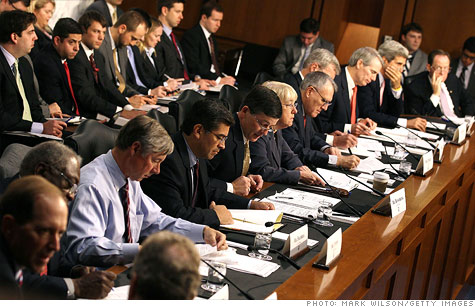
Ideological differences and a seeming lack of political will on both sides of the aisle continue to stymie debt committee efforts to forge a compromise on debt reduction.
NEW YORK (CNNMoney) -- Well, here we are again. You can count the hours to yet another deadline, and Congress remains deadlocked over debt and taxes, this time through its proxy -- the bipartisan debt committee.
First there was the government shutdown threat in the spring. Then there was the threat of a U.S. default this summer during the debt ceiling debate. And, to top it all off, a downgrade.
At least this time, shutdowns and defaults really aren't a threat if the super committee fails to approve a debt-reduction plan by Wednesday -- its official deadline.
So what is the super committee trying to accomplish and what's at stake? (The latest: A deal is doubtful)
How much they'll cut: No one knows ... still.
"Go big" advocates have been pushing the committee to agree to a plan that reduces deficits by at least $3 trillion to $4 trillion over the next decade. Their preferred formula: a mix of spending cuts and tax increases that would be phased in so as not to upend the economic recovery.
With only days to Wednesday's deadline, the chance that the committee will reach a "grand bargain" appears to be on life support, and the priest is on his way to deliver last rites.
Instead, the parties, if they can strike a deal at all, are more likely to produce a plan that cuts deficits by $1.2 trillion or less. The plan would likely include a mix of spending cuts and revenue increases.
If they manage to seal a deal on $1.2 trillion, that would stave off what some call "devastating" automatic spending cuts to defense and nondefense spending in 2013.
But if all they do is $1.2 trillion, that means U.S. debt would continue to grow faster than the economy. And lawmakers will get to have this painful debate over and over until they get it right.
It's unclear whether any deal would also include measures intended to support the economic recovery, such as an extension of temporary payroll tax relief.
The biggest sticking points: Same ol', same ol'.
Democrats and Republicans still can't come to bipartisan agreement on two central issues: the best way to increase tax revenue and reduce social program spending; and by how much.
Progressives have pressured Democrats to make no cuts to entitlement programs -- direct or indirect; and conservatives have pressured Republicans to refuse any tax increases that don't arise organically from economic growth.
Democrats and Republicans on the super committee, however, have made attempts at compromise.
Republicans offered a plan that limited tax breaks in a way that would raise $250 billion. In exchange, they proposed lower rates. They estimate that the reform would lead to economic growth that would raise another $110 billion. In addition, a change to how tax brackets are adjusted for inflation would raise another $40 billion.
In response, Democrats initially said the additional tax revenue wasn't enough, but later said they could agree to the GOP revenue number but not how the revenue would be generated. Republicans weren't happy. Of late, a lot of energy has been spent by each side blaming the other for the impasse.
What if they reach a deal ... or don't: The magic number is seven.
The 12-member super committee needs a simple majority to pass any proposal.
If the panel approves a plan, the House and Senate will vote on it, without amendment, by Dec. 23. Only a simple majority in each chamber is required for the plan's passage.
Fiscal hawks worry that the committee, unable to agree on substantive issues that can curb long-term debt, will instead populate the plan with small-fry spending cuts and a variety of "fake" savings.
If the super committee fails to agree on any plan, then $1.2 trillion in automatic cuts to defense and nondefense spending would kick in starting in 2013. Exempt from the cuts: Social Security and programs for low-income people, such as Medicaid. Medicare cuts, meanwhile, would be limited.
If the committee agrees on a plan worth less than $1.2 trillion, the "sequester" of cuts would make up for the difference between what the super committee proposed and $1.2 trillion. So if the committee settles on $600 billion, another $600 billion of automatic cuts would take effect in 2013.
But there are two reasons why that sequester may not occur: Lawmakers may choose to amend or repeal the cuts; or they may use the year they'll have before the cuts kick in to come up with a comparable deficit-reduction plan. ![]()
| Overnight Avg Rate | Latest | Change | Last Week |
|---|---|---|---|
| 30 yr fixed | 3.80% | 3.88% | |
| 15 yr fixed | 3.20% | 3.23% | |
| 5/1 ARM | 3.84% | 3.88% | |
| 30 yr refi | 3.82% | 3.93% | |
| 15 yr refi | 3.20% | 3.23% |
Today's featured rates:
| Latest Report | Next Update |
|---|---|
| Home prices | Aug 28 |
| Consumer confidence | Aug 28 |
| GDP | Aug 29 |
| Manufacturing (ISM) | Sept 4 |
| Jobs | Sept 7 |
| Inflation (CPI) | Sept 14 |
| Retail sales | Sept 14 |